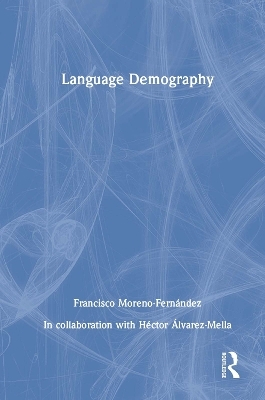
Language Demography
Routledge (Verlag)
978-1-032-35539-9 (ISBN)
Language Demography presents, exemplifies, and develops linguistic concepts involved in demography and the demographic concepts involved in sociolinguistics.
The first introductory guide of its kind, it is presented in a way that is accessible to non-specialists. The book includes numerous examples of the sources and types of data used in this field, as well as the various factors affecting language demography. Taking a global perspective supported by examples, it gives explanations of how demolinguistic analyses are performed and their main applications in relation to minority and majority languages.
Language Demography will be of interest to students from a range of disciplinary backgrounds, from linguistics and modern languages to sociology, anthropology, and human geography.
Francisco Moreno-Fernández is Alexander von Humboldt Professor at Heidelberg University, Germany, Director of the Center for Ibero-American Studies, and honorary Research Professor at the University of Alcalá, Spain. He is a full member of the Academia Europaea and the Academia Norteamericana de la Lengua Española, and a corresponding member of the Cuban, Mexican, and Chilean academies of language, as well as the Real Academia Española. He directed the Cervantes Institute centers in São Paulo and Chicago. He was academic director of the Instituto Cervantes (Madrid) and director of the Observatory of Spanish and Hispanic Cultures of the Instituto Cervantes at Harvard University, USA.
Introduction
1. Demography and Demolinguistics
Demolinguistics and Geodemolinguistics
Demolinguistics and Geography
Denominations for Demolinguistics
The Precursors of Demolinguistics
Summary
2. Linguistics for Demographers
Fundamental Linguistic Concepts
Geographic Considerations
Psychosocial Considerations
Social and Ethnic Considerations
Language Vitality
Summary
3. Demography for Linguists
Population
Composition of the Population
Population Distribution
Demographic Changes
Migrations
From Facts to Theories
Summary
4. Demolinguistic Data and Sources
Data
Sources
Administrative Registers
Censuses
Surveys
International and Digital Sources
Encyclopedias, Catalogs, and Other Sources
Summary
5. Demolinguistic Factors
Speakers and Their Communities
Speaker Profiles
Explanatory Factors
Summary
6. Demolinguistic Analyses
Objectives and Levels of Demolinguistic Analysis
Qualitative and Quantitative Analysis
The Statistical Elements of Demography
Errors, Biases, and Changes in Criteria
Graphical Representations
Summary
7. Applications of Demolinguistics
Ethnic, Local, and Social Minority Languages
Immigrant Minority Languages
Regional and National Languages
Transnational Majority Languages
Summary
Conclusion
| Erscheinungsdatum | 02.08.2023 |
|---|---|
| Zusatzinfo | 23 Tables, black and white; 5 Line drawings, black and white; 46 Halftones, black and white; 51 Illustrations, black and white |
| Verlagsort | London |
| Sprache | englisch |
| Maße | 156 x 234 mm |
| Gewicht | 580 g |
| Themenwelt | Geisteswissenschaften ► Sprach- / Literaturwissenschaft ► Anglistik / Amerikanistik |
| Geisteswissenschaften ► Sprach- / Literaturwissenschaft ► Literaturwissenschaft | |
| Geisteswissenschaften ► Sprach- / Literaturwissenschaft ► Sprachwissenschaft | |
| Sozialwissenschaften | |
| ISBN-10 | 1-032-35539-5 / 1032355395 |
| ISBN-13 | 978-1-032-35539-9 / 9781032355399 |
| Zustand | Neuware |
| Haben Sie eine Frage zum Produkt? |
aus dem Bereich


